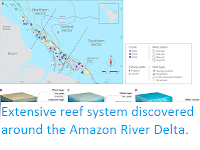The tropical seas are noted for their extensive Coral Reef systems, though Corals are far from being the only reef-forming organisms in the seas. Coraline Algae are Rhodophytes (Red Algae) that form extensive reef systems in temperate waters, though they are seldom observed as they favour nutrient rich waters (which tend to be opaque) and depths of greater than 10 m. Algal Reefs also occur in tropical and sub-tropical environments, though they are much less common here, typically only being found in areas of high sedimentation, which excludes most Coral species.
The reef covers an area about 27 km long and 450 m wide, in an area with a tidal range of about 4 m, exposing much of the reef at low tides. It has a porous structure, being made up of stacked layers of Algae, predominantly of the genera Mesophyllum, Phymatolithon, and Harveylithon, as well as sediment-tolerant Corals such as Cyphastrea and Dipsastraea. Carbon-dating of drilled cores from the Reef suggests it began to form about 7500 years ago.
Coraline Algal Reef during low tide with windmills in the background. Liou et al. (2017).
Liou et al. suggest that the Taoyuan Reef is likely to perform similar ecosystem services to similar sized Coral Reef systems, and note that it is home to little-known and probably rare species such as the newly discovered Coral Polycanthus chaishanensis, and at least two species of as yet undescribed Corals. They also note that it is threatened by coastal developments in the area, including a planned industrial park and wind farm.
Detail of a section of the Reef showing undescribed Crustose Coraline Algal species, Phymatolithon sp. nov. (left) and Mesophyllum sp. nov. (right). Liou et al. (2017).
See also...








